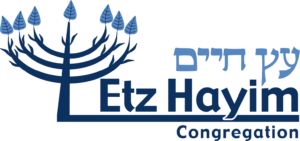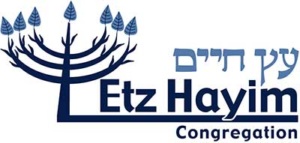Plantain latkes at Chanukah. Arroz y habichuelas (rice and beans) on the Rosh Hashanah table next to Big Mama Tillie’s roast brisket. Flan de queso crema (cream cheese custard) for Shavuot.
While those might be run-of-the-mill Jewish holiday dishes in some parts of the world, it was completely unheard of in my Ashkenazi upbringing in Silver Spring, Maryland. Of course, that is before I met Luis.
Seventeen years ago, I dragged myself off of my sofa in my apartment on Capitol Hill to go to a party in Ballston. Why? Because a friend told me that a cute Jewish guy was going to be there.
I met the Jewish guy. Eh, he wasn’t for me. But the person who really impressed me was his roommate, Luis, a Puerto Rican man who spoke with kindness and humor in heavily accented English.
We started dating with few expectations about where the relationship would go, though after a few months, it became clear that this was It. However, Luis wasn’t Jewish, and I wouldn’t ask him to convert. What would this mean for my Jewish identity—and the eventual children I hoped to have and raise as Conservative Jews?
Dr. Marion Usher’s new book, One Couple, Two Faiths: Stories of Love and Religion, contains scores of personal stories, like my own, illuminating the different paths that couples and families follow when deciding how to build relationships based on—and despite—religious differences.
Usher takes decades of expertise in counseling interfaith couples and their loved ones in Washington, DC, and provides a practical guide to making Judaism a “center of gravity” in a family, as it was in hers growing up in Montreal, Canada.
As Usher describes in detail and through multiple anecdotes, Judaism isn’t just a religion or an ethnicity; it’s a myriad of things to myriad people who identify as Jewish in their own way. The question she prompts the reader to ask herself is: How do I express my Judaism?
This is the same question I had to ask myself once my relationship with Luis got serious. I went to my grandma Tillie (aka Big Mama), who was a spry, lucid 88 at the time (she’ll be 103 this October, kinahora) and asked her, “Mama, can I marry a non-Jew?”
What would my deeply traditional Big Mama—who had as dedicated and loving a Jewish marriage as anyone could dream for—say about marrying a non-Jew?
In her frank and honest manner, Mama said, “Is he kind? That’s what matters. You found a nice man who is nice to you and good for you.” And in her not-so-subtle way of reminding me that I am far from a perfect person, she added, “I hope that you’re good for him.”
Our interfaith and interracial Jewish marriage is not without its challenges, yet over the past 13 years we have chosen to work together and use our trials to strengthen our partnership. I’ve learned Spanish to better communicate with Luis’ family, and Luis took Hebrew classes with our synagogue’s Adult Education program. He also learned a little Yiddish, much to Mama’s delight and amusement. While he’s never developed a taste for gefilte fish, Mama always makes sure there is a bowl of tuna salad on our holiday table just for Luis. And so many culinary delights, such as plantain latkes, have sprung from our union of Jewish and Puerto Rican cuisine.
Luis and I use our shared values to keep the Jewish home and raise the Jewish family that is right for us. Conservative Judaism didn’t lose a daughter when I intermarried; it gained a son.
We recognize the responsibilities that come with the privileges afforded to us. It is not enough that we signed a ketubah and danced the hora at our wedding. Several months before we decided to marry, we promised each other that it is our sacred responsibility to teach our eventual children about Jewish values and Torah, as well as the value of building significant relationships with the local Jewish community and with Israel.
We are blessed to have found Congregation Etz Hayim in Arlington, Virginia, a welcoming spiritual home based in Conservative Jewish liturgy with a rabbi who is open to meeting families where they are in Jewish observance. Accepting our intermarried status inspired Luis and me to become involved in the community and, as a result, more rigorous in our Jewish observance.
This is absolutely key, according to Usher: “The greater Jewish community must take responsibility for including and incorporating interfaith families and allowing the families to experience what Judaism has to offer as a religion and as a caring community.”
The 2017 Greater Washington Jewish Community Demographic Study revealed that as intermarried couples outnumber those who are in-married, more Washington-area Jews attend services and programs than belong/pay dues to synagogues. Just 31 percent of area Jews belong to a synagogue, below the 39-percent national average.
Usher sees this as less of a challenge than an opportunity for traditional “brick-and-mortar” synagogues, particularly within the Conservative movement. “It’s all about nuance,” she said, “Pushing the edges where they can be pushed and where people can feel included.”
She states that if individual synagogue boards of directors are open to inclusion, the congregation will follow. She uses the example of the interfaith aufruf performed by Rabbi Gil Steinlauf, formerly of Adas Israel Congregation in Washington, DC, to illustrate this point. Usher recalled, “While he couldn’t marry the interfaith couple, he made a blessing on the bima to bless the couple. That was a huge statement.”
Whatever our martial status, we each have unique circumstances and challenges that require varied solutions. Usher explains what binds us as Jews: “Being charitable is one of the three important tenets of Judaism. These pillars are tefillah, teshuvah and tzedakah—studying, remembering what gives meaning to our lives and doing acts of kindness.”
Ultimately, this all comes back to food and the power of food to draw people together. We could be called the People of the (Recipe) Book. Unsure how to reach out to an interfaith family in your community? A meaningful, low-barrier way to make them feel welcomed and build relationships is through sharing recipes and meals. This theme crops up time and again in One Couple, Two Faiths. Try making one of Dr. Usher’s family recipes, my interpretation of tuna noodle kugel, or a dish based on your heritage and that of the couple you wish to honor.
These small gestures, Usher says, are “not earth shattering; it’s just once inch at a time.” As Big Mama Tillie would advise, it’s the kind thing to do. And that’s what matters.
Dr. Marion Usher’s guide to interfaith relationships, One Couple, Two Faiths: Stories of Love and Religion, is available locally at Politics & Prose Bookstore and on Amazon.
–Stacey Viera
Stacey Viera has held multiple leadership positions at Congregation Etz Hayim in Arlington, VA. She currently serves as Secretary. She is a Communications Strategist, Storyteller and Food Writer & Photographer.
Website – www.StaceyViera.com
Blog – www.everyfoodfits.com
Twitter – @staceyviera

